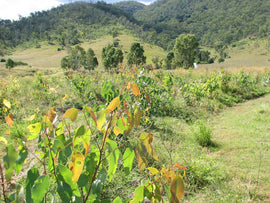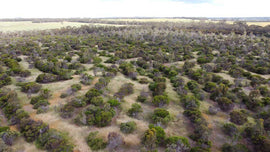Located about 40 kilometres west of Mansfield, the site has retained a few old trees but has primarily been grazed for decades and the soil was highly compacted.
The key objective was to create a permanent forest sink that will provide a range of environmental services including soil and water conservation, biodiversity conservation, connectivity with a neighbouring property remnant forest and recapturing carbon emissions.
As with the vast majority of Greenfleet planting projects, the landholder paid for the site preparation, rabbit removal, weed spraying and fence repairs,and assigned the carbon rights on the property to Greenfleet, while Greenfleet (through its supporters) paid for the trees themselves.
It was important to the landholder, that a number of actions were implemented by the forest manager to reduce emissions during the establishment of the planting project. This included well-serviced equipment, no fertiliser use, efficient transport methods and other management actions to the best of their ability.
In September 2009, 7ha of the property was planted with 8,000 seedlings, using traditional site preparation methods of ripping to allow moisture to return to the highly compacted soil, spraying to reduce competition from weeds, planting and follow-up weed maintenance.
Twelve different species of Australian plants, native to the area, were selected to guarantee maximum survival and restore the natural flora and fauna of the area. The seed was collected on the property and the immediate surrounding area.
Greenfleet Foresters completed the first survival assessment survey in January 2010. The survival rate was 79%, with nearly all losses in an isolated section due to browsing by some rabbits and kangaroos. Greenfleet plans to replant these areas in 2011, as the Sheoaks (Allocasuarina verticillata) in particular were targeted by the animals - guards will be used to reduce the risks of future browsing.
Overall, most seedlings are doing well with excellent growth in the majority of sections. There have also been sightings of Wedge-tailed Eagles, Rosellas, Swallows, Honeyeaters and marsupials.
"With the benefit of a good season the little trees are booming. It just goes to show that planting local species can rapidly transform a tired old paddock," said Sara Gipton, landholder.

Location Size
Planting Dates
Species
- Acacia dealbata
- Acacia implexa
- Acacia mearnsii
- Acacia paradoxa
- Acacia pravissima
- Acacia pycnantha
- Allocasuarina verticillata
- Eucalyptus macrocarpa
- Eucalyptus melliodora
- Eucalyptus microcarpa
- Eucalyptus polyanthemos
- Eucalyptus rubida




